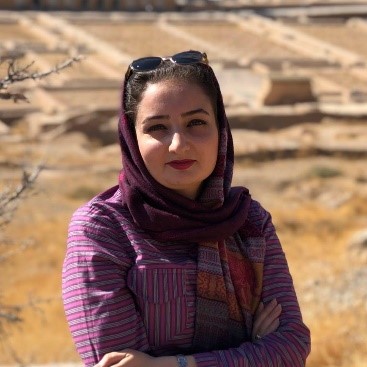Day 1 :
Keynote Forum
Mina Hosseinpourtehrani
Kim Maund University of Newcastle, Australia.
Keynote: Landslide Hazard Zonation Mapping along national highway: NH-125, Pithoragarh-Kanthgaon Area, Uttarakhand,India
Time : 10:00

Biography:
Mina Hosseinpourtehrani is a PhD student from the University of Newcastle, Australia under supervision of A.Prof Ahmed and Dr. Maund. Her research is about post-disaster water, sanitation and hygiene provision and she is trying to propose a model of collaboration between the government organizations and NGOs in the context of WaSH governance in her thesis.
Abstract:
In the context of water, sanitation and hygiene (WaSH), the impact of disasters such as floods, droughts, cyclones, and earthquakes varies from the extreme destruction of WaSH infrastructures and services to the quality and quantity of water resources. Inadequate sanitation and water supplies and poor hygiene behaviour in the aftermath of these disasters are generally significant reasons for diverse communicable and infectious diseases, thereby exposing many people to illnesses and death. Therefore, providing WaSH services is a critical requirement for survival and health in the initial stages of occurring a disaster and different actors have to solve such complexities in response to disasters. One of the issues that have been mostly associated with WaSH is the management and governance of the WaSH service provision after disaster. A critical aspect of governance is the involvement of state and non-state actors and their level of participation. In this study, the main WaSH governance issues in the context of disaster is reviewed indicating the importance of collaboration between government and NGOs in post-disaster WaSH service provision.
Keynote Forum
HimanshuPandey
L. S. M.Govt. P. G.College, India
Keynote: Landslide Hazard Zonation Mapping along national highway: NH-125, Pithoragarh-Kanthgaon Area, Uttarakhand,India
Time : 10:50

Biography:
Himanshu Pandey is in the IV semester of master in science in Geology in L. S. M.Govt. P. G.College, Pithoragarh, Uttarakhand,India. Research interest in Geodynamics.
Abstract:
Landslide is one of the most common natural hazards that affect human population directly and also indirectly by causing fatal accidents, roadblocks and loss of biodiversity.The present study deals with the preparation of Landslide Hazard Zonation (LHZ)map along national highway NH-125 from Pithoragarh to Kanthgaon.This area lies in the calc zone of Pithoragarh.The presence of steep slopes,faults,shear zones along with extreme rainfall during monsoons make it very prone to landslides.This area is a part of government’s multipurpose project to prepare all weather roads.It serves as a route of pilgrimage for the KailashMansarovaryatra and is also very close to the tri-junction of India,China and Nepal.This road often gets blocked due to mass-wasting in various forms.Hence, this study has been done to delineate the landslides and understand the cause of their occurrence.Both remote sensing and in-field techniques have been utilized for the study.Remote sensing techniques include the use of SRTM data,Google imagery, topographic, hydrological and other maps.In field techniques include geological studies and recheck of the observations made using remote sensing data. Factors such as hydrology, slope, overburden thickness, slope and discontinuity relation, joint and fracture, weathering, rock mass, lithology and vegetation type along with the precipitation data have been utilized for the calculation of Landslide Suceptibility Score(LSS) and the preparationof LHZ map.The investigations and interpretations of present study may be used by the workforce responsible for the ongoing project so that their objective of public welfare is fulfilled.District administration can use this LHZ map for early warnings to overcome landslide hazards.
Keynote Forum
Azin Fathianpour
Massey University, New Zealand
Keynote: Configuring evacuation infrastructure resilience
Time : 10:00

Biography:
Azin Fathianpour is a PhD student at Massey University. She has completed her first year of study and is studying Construction Management under the supervision of Prof. Suzanne Wilkinson.
Abstract:
Many people in the world live in hazardous environments and are susceptible to disasters. In the time of a destructive event, a resilient community must be prepared, able to mitigate the event and quickly respond. An effective mitigation plan can lead to fewer fatalities and damages.
One of the most critical tasks for mitigation is the evacuation process. Wherein, short notice time, and overcrowding and pushing in crowds, bottlenecks in infrastructure and steep slopes may worsen the situation. The evacuation process encompasses, amongst other things, transportation infrastructures to be named corridors, signs, pedestrian footpaths, and/or shelter infrastructures for keeping people safe. Evacuation infrastructure can also become damaged after the event.
This paper aims to investigate evacuation infrastructure in terms of different resilience features, such as redundancy, safe to fail, readiness, capacity. A systematic methodology for reviewing articles has been implemented to understand how vulnerable cities can be more prepared, especially for pedestrian evacuation. An evacuation scoring system for pedestrians will be developed.
This study will investigate the characteristics of the available evacuation infrastructure and outlines the general drawbacks. The most practical evacuation system will be estimated with a final output being to provide the characteristics of a successful pedestrian evacuation system for future policy use.
Keynote Forum
Azimollah Aleshzadeh
Istanbul Technical University
Keynote: Landslide Susceptibility Assessment by Information Entropy Model, Uzundere NE Turkey

Biography:
Azimollah Aleshzadeh has completed his BA degree (2002) and MA degree (2007) from Sahand University of Technology, Iran. He is the PhD Candidate at the Graduate School of Science Engineering & Technology at Istanbul Technical University.
Abstract:
The main objective of this research is to evaluate the results applying the Information Entropy Method (IEM) for predicting landslide susceptibility in Uzundere County, Erzurum Province, Turkey. To do this, first, 42 past landslide occurrences were mapped in the GIS environment. 30 (70%) out of the landslides were selected for the modeling and the remaining (30%) were employed for validation of the model. Afterward, 12 landslide contributing factor layers were prepared including distance from settlements, local relief, dominant soil, total curvature, drainage pattern, drainage proximity, road buffer, ruggedness number, lithological units, slope inclination, slope orientation, and compound topographic index (CTI). The relationships between landslide distributions and these factors were determined using IE model and the results were then used to calculate the landslide susceptibility of the entire study area. To verify the model, the results were compared with validation landslide data not employed in training process of the model. Accordingly, Receiver Operating Characteristic (ROC) curves were applied, and Area Under the Curve (AUC) was calculated for the obtained susceptibility map using the success (modeling data) and prediction (validation data) rate curves. The validation results showed AUC = 72.36 % and AUC = 70.15 % for success and prediction rates, respectivly. The landslide susceptibility map produced from this research were successful and can be useful for general land use planning and future hazard management purposes.
Keynote Forum
Meda Gurudutt Prasad
CADME (Coastal Area Disaster Mitigation Efforts), India
Keynote: Community resilience in india

Biography:
Meda Gurudutt Prasad is currently worked in CADME (Coastal Area Disaster Mitigation Efforts), India
Abstract:
CADME believe in the importance of disaster risk reduction measures at each level of community, specially supporting vulnerable and Risk people with the interventions in order to prevent their vulnerabilities and promote the sustainability of the project by giving to them a voice for their needs and concerns during disasters.
Leverage the unique opportunity of parallel thematic frameworks
Communities do not perceive or experience risks in isolation. Problems on the ground are multi-faceted and inter-linked, failing to fit neatly into sectoral boxes. Governments in Asia must ensure that Sendai action plans strengthen coherence with the Sustainable Development Goals.
Actively include and safeguard the interests of the most at-risk people
The implementation of Sendai action plans must be done in partnership with those most at risk and should begin at the community level.
Build local leadership to innovate DRR
It is at the local level where risks and disaster impacts are felt most acutely. Every community faces varied risks and triggers, but also have inbuilt coping mechanisms and wisdom that can be tapped. Local leadership, including delegation of financial and monitoring powers, is essential.
Finance DRR at the local level
Consultative participation alone provides little scope for equitable partnership
Build an evidence-base for planning and implementation
Decision-making must be informed and risk sensitive. Countries must build and make evidence-bases easily accessible, including ecosystem based mapping of vulnerabilities.
